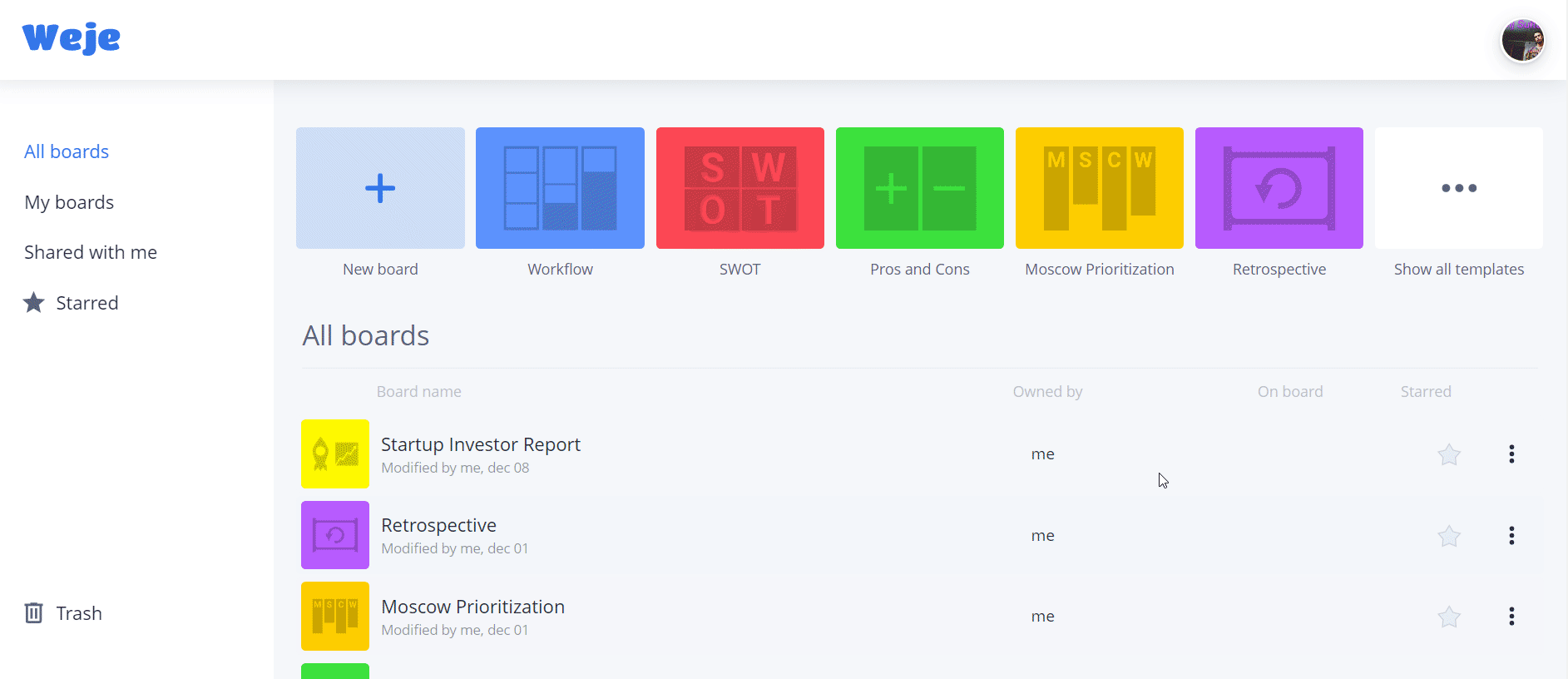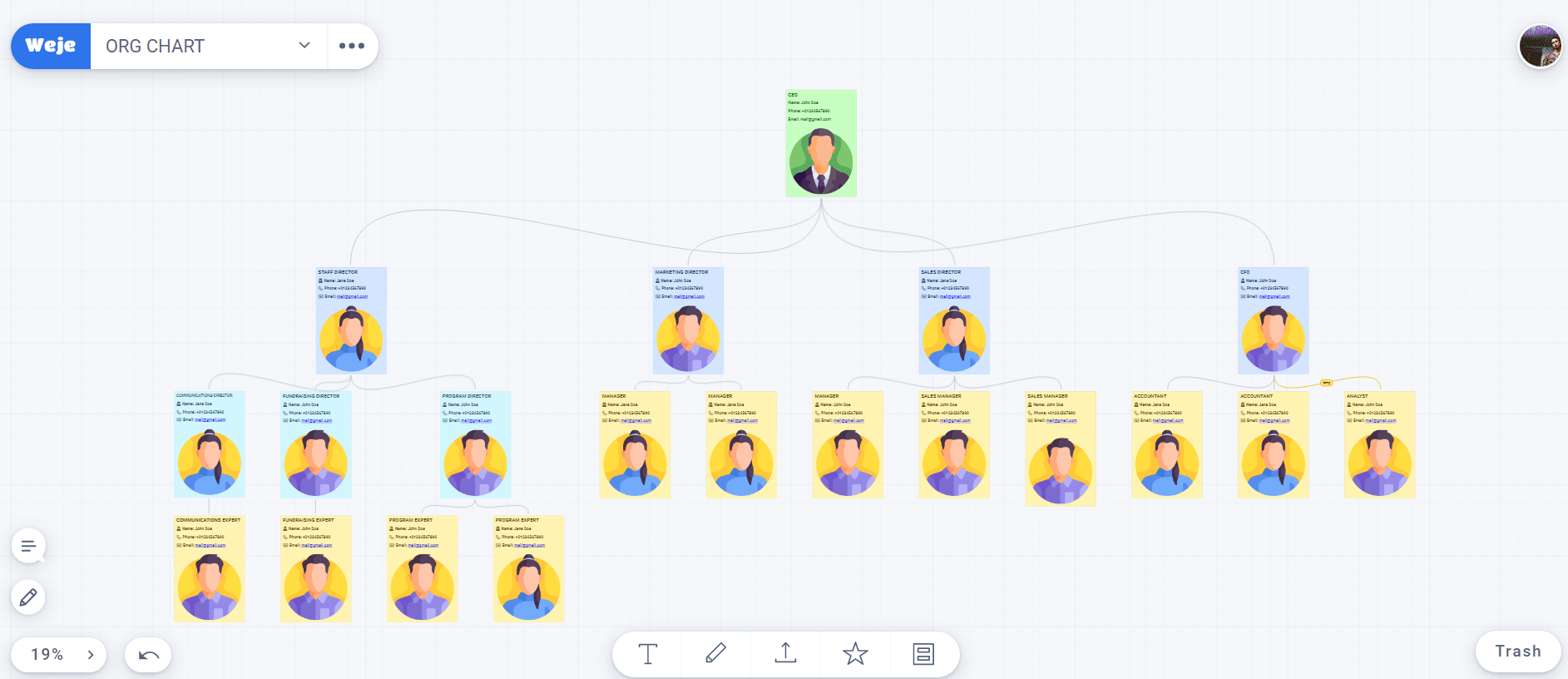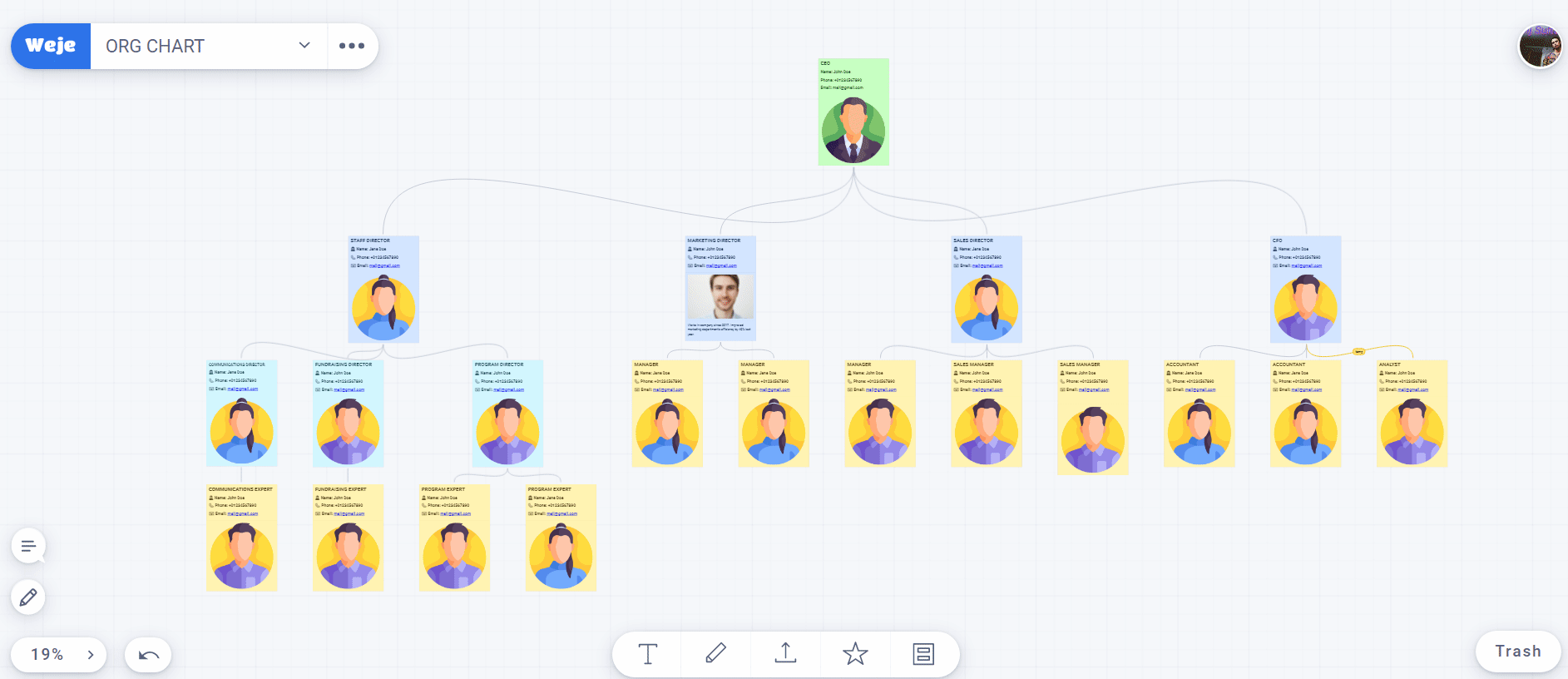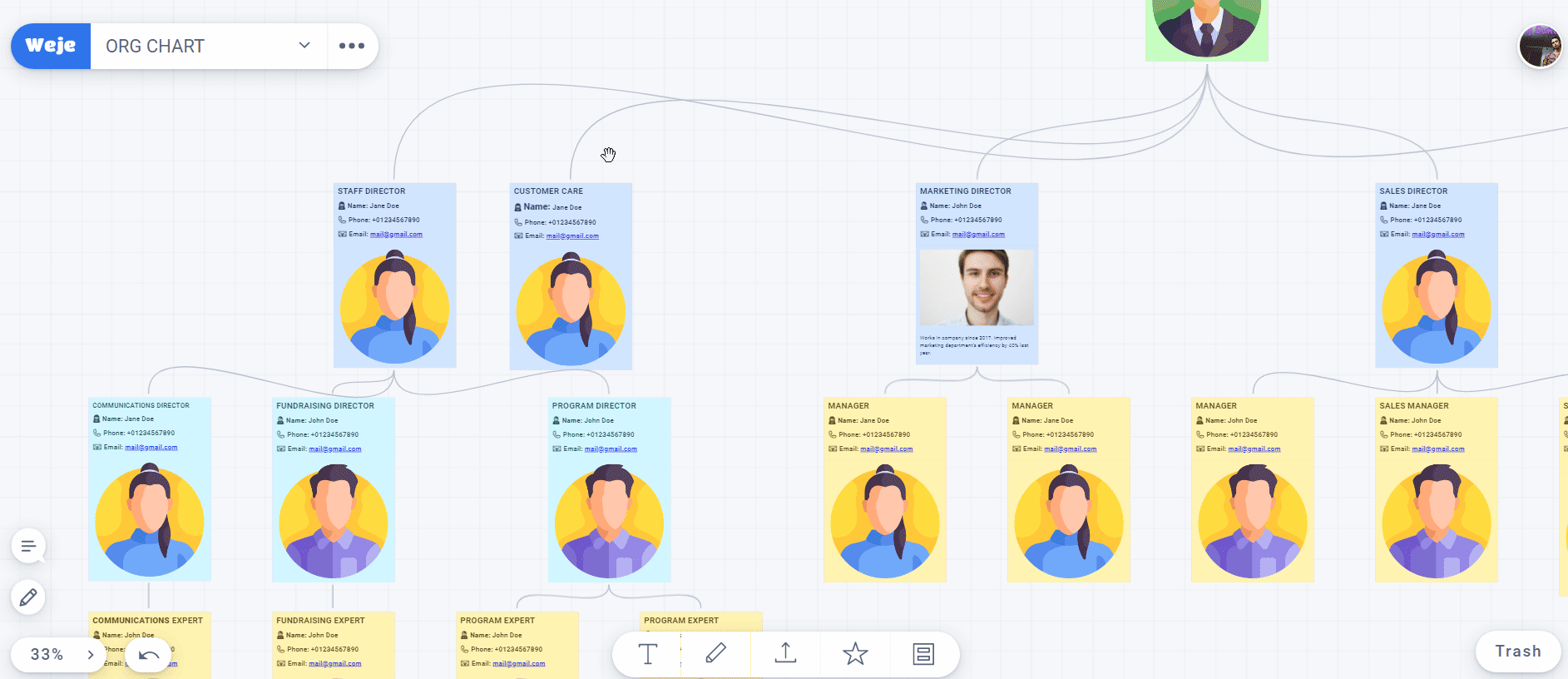An organizational chart is a visual representation of how things work in your company and how responsibilities are shared between departments and people.
This tool helps you better grasp the structure of your company at full scale and quickly share this knowledge with partners and new team members. Having a complete org chart in front of your eyes also helps you identify weak spots in your organization and find room for improvement and optimization. Hopefully, this article will make org chart creation easier for you.
Let’s get started by learning about different org chart types. This will help you find the best type for your situation.
Types of organizational charts
Org charts vary depending on their structure. The most frequently used org charts are matrix, functional, flat, and divisional types. Let’s briefly review each one.
Functional top-down
This type of org chart is built based on the hierarchy in every department — sales, marketing, customer support, etc. This model is frequently used by small organizations since it doesn’t require multiple layers of categories, and only contains information about the departments, team members, and their duties.
A functional top-down org chart has a simple logic so it’s easy-to-build. It allows you to better understand each departments’ set of responsibilities and quickly pass this information to whom it may concern. You will have a chance to build your own functional top-down org chart later in the article.
Matrix organizational chart
This org chart type is used for managing information on multiple levels. Matrix organizational charts may cover, for instance, geographical and structural aspects of the company at the same time.
This org chart type is theoretically helpful for managing multiple organizational dimensions simultaneously, but it’s rather hard to do. Large companies prefer to create several charts individually for different departments in various locations. This makes it easier to navigate and understand the hierarchy in the company to a certain level but does not give the full picture.
Divisional structure
This org chart is used to represent a multilayer hierarchical structure where various departments work independently from one another. This org chart type is frequently utilized by companies that produce various lines of products to separate departments and avoid unnecessary complexity in relationships between marketing, sales, and customer support teams.
Flat organizational chart
The flat organizational chart is considered an experimental model. It has a horizontal structure with only few or even no levels. By using this organizational approach, companies may develop alternative ways to build good communication between departments and their workers as they avoid the standard and sometimes a non-effective and slow chain of command. The flat org chart is a sign that the company supports self-management and autonomous decision-making in the team.
Let’s learn more about using an organizational chart.
How to create an org chart
Creating an org chart requires an understanding why you need to create such a chart, and finding the right org chart creation tool. Here are the four basic steps required for any org chart creation.
Define scope
Decide upon who you need to include in your org chart. For instance, an org chart may only represent team members, who work in the office, excluding partners and external stakeholders, and vice versa. Depending on your company’s type and size, you can create the simplest model or try and build a multiple-layer chart, consisting of smaller autonomous charts.
Collect data
Survey your team members individually via email or group chat, or work with your HR department to get all the necessary information about each person in the company. It’s best to store gathered data in Excel or Google Sheets, separated by columns with different types of information, like Name, position, experience, assignments, etc.
Choose tools for building your chart
It’s time-consuming and inefficient to draw out your org chart by hand. Let’s work with a smart online tool, like Weje, to avoid wasting paper and ensure that all data is stored online so you won’t forget or miss anything.
Weje is an online multifunctional whiteboard that allows you to quickly create a well-structured and shareable organizational chart from scratch or based on a free template. Let’s try to create your first sample of an org chart together.
Draw your chart
Here is what you need to do to craft a basic functional top-down org chart. Once you’ve registered at Weje, go to “Show all templates” on your dashboard and find the ORG CHART template.

Customize the cards by changing photos, adding a job description, contact details, and any information you find necessary.

In Weje, you can easily copy cards. Click on the card and find a “copy” icon. Customize it like any other card on your whiteboard. Once customized, connect the card with other cards if you need to. Just click on the card, find a dot on its side, click and hold it, and hover it to a dot on another card to make a connection. Note, that connections are also customizable — use different color and line types to better reflect the relationships between your departments and team members.

Once your org chart is completed, you can share it with collaborators, new team members, and stakeholders. Find a menu in the upper left-hand corner and customize the access settings. For instance, you can make your board public to everyone on the internet with the rights to edit or view the document. You can also make it private (which is the best option for sensitive personal information) and invite people individually by entering their email addresses.

Now, as you’ve learned how to draw an organizational chart in Weje, let’s get inspired with some useful tips to make org chart creation even easier.
You can watch the full video about the organizational chart template here:
Org chart best practices
We’ve collected four simple tips to help you quickly create an effective org chart. Here they are.
Visualize reporting relationships
Make sure it’s clear exactly how the departments and team members exchange information. This will make onboarding of new hires faster, allowing new workers to get acquainted with the teammates and remember roles in the company in a blink of an eye. Using something visual like a resource Gantt chart will help tell you what your team members are up to instantly
Only show formal relationships
An organizational chart is not an official document, but this doesn’t mean that it’s proper to add any information irrelevant to the business. Personal relationships in all their complexity and beauty unfold in face-to-face communication, so let it happen organically when the new team member starts to interact with their teammates.
Manage access to the org chart
It’s best to make your organizational chart a shareable online document to save time and resources. Make sure to set proper access settings so that no one could accidentally spoil the document. It’s also necessary to keep the sensitive information safe, so it’s better to share your org chart only via personal email invitations.
Schedule regular updates
As time passes by, the company changes: people come and go, new departments are being created or abolished, new types of tasks appear. Think about how often you plan to update your organizational chart because it’s necessary to make your chart represent the current situation. It’s best to assign a person responsible for maintaining the document, so consider choosing someone from the HR department since they have all specific information about team members by default.
Let’s finish our guide by realizing that in some cases an org chart may not be necessary.
Why are org charts may not be helpful?
Here are three reasons that make organizational charts inefficient in some situations.
- Org charts get outdated quickly. Since companies restructure and change team roles from time to time, you risk having outdated information in your org chart that may only make things worse for new hires. It’s necessary to maintain your organizational chart a helpful resource, so consider assigning a person responsible for updating your document.
- Only reflects formal relationships. Org charts are not particularly designed to give an in-depth view of how things work in the company. Remember this fact and try to maintain your org charts meaningful. Avoid unnecessary details and keep in mind that relationships at work are deeper and more complex than it may appear in the document.
- Does not reflect management style. Org charts are not based on in-depth analysis of each manager, thus important details may be missed or misinterpreted. To avoid any nonsense, use your organizational chart as the first point of reference. Mind that personal contact is the optimal way to better understand relationships between teams and departments.
Congratulations, now you know what org charts are, how to build them properly, and how to avoid conceptual misunderstanding of this document. Join Weje today for more useful templates and information.
Published: December 16, 2021





